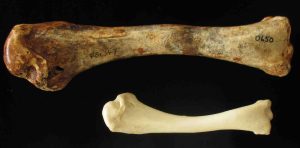
A giant, flying turkey as tall as a kangaroo once roamed Australia, palaeontologists said Wednesday, after an analysis of fossils and bones from around the country revealed five extinct bird species.
A team from Flinders University in South Australia said they were all chunky relatives of today’s malleefowl and brush-turkeys.
The megapode birds lived during the Pleistocene era, between 1.6 million and 10,000 years ago, alongside other giant Australian animals like diprotodons, marsupial lions and short-faced kangaroos.
Scientists had initially thought the fossils, first found in the 1880s, represented a single ancient bird, but fresh examination has led them to conclude they belong to five different species.
Among them was a turkey weighing up to eight kilograms (17 pounds) and standing taller than a grey kangaroo, which can reach 1.3 metres (4ft 3ins)—four times the size of modern fowl.
“These discoveries are quite remarkable because they tell us that more than half of Australia’s megapodes went extinct during the Pleistocene, and we didn’t even realise it until now,” said researcher Elen Shute.
“We compared the fossils described in the 1880s and the 1970s with specimens discovered more recently, and with the benefit of new fossils, differences between species became really clear.”
The newly found birds fall into two categories—”tall turkeys” that had long, slender legs, and “nuggetty chickens” that had short legs and broad bodies.
Unlike many large extinct birds, such as dodos, these megapodes were not flightless.
While big and bulky, their long, strong wing bones showed they could all fly, and probably roosted in trees, unlike their modern ground-dwelling cousins which build mounds to incubate their eggs.
Two of the new species come from the Thylacoleo Caves beneath Australia’s vast Nullarbor Plain, which have proved a treasure trove since they were discovered 15 years ago.
“So far the Thylacoleo Caves have yielded seven new species of kangaroo, a frog, two giant ground-cuckoos, and now two new megapodes,” said Flinders professor Gavin Prideaux.
“The closer we look, the more we keep finding.”
Reference:
“Taxonomic review of the late Cenozoic megapodes (Galliformes: Megapodiidae) of Australia,” Royal society open science Published 14 June 2017.DOI: 10.1098/rsos.170233
Note: The above post is reprinted from materials provided by AFP.










